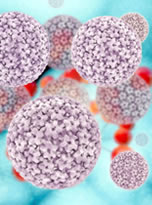Read and report vaccine reactions, harassment and failures.
Quick Facts
HPV

- Human papillomavirus (HPV) is the most commonly sexually transmitted infection in the U.S. and there are more than 200 known HPV types, the majority of which are not harmful. About 75 percent of HPVs have been associated with non-cancerous warts (papillomas) on the hands, chest, arms and feet, such as low-risk HPV types 6 and 11;
- About 40 HPV types in the surfaces of the cervix, vagina, vulva, anus, penis, mouth and throat, and include the most common high-risk cancer-causing HPV types 16 and 18. High-risk HPV types are associated with development of cancer of the cervix and five other genital and oral cancers affecting women and men;
- Most sexually active women and men become infected with HPV and over 90 percent clear the infection within two years. Antibodies from prior infections help prevent future re-infection by the same HPV type. Chronic infections are rare and occur mostly in women. Chronically infected women who don’t get pre-cancerous cervical lesions promptly identified and treated can develop cervical cancer and die. High risk factors for developing HPV-related cancers include: smoking, multiple sexual partners, long-term oral contraceptive use, multiple births, weakened immune system, co-infection with chlamydia or HIV, poor nutrition, heavy drinking and smoking, and chronic inflammation;
- After Pap smear tests that screen for cancerous conditions became a routine part of gynecological health care for American women in the 1960’s, U.S. cervical cancer cases dropped by 75 percent. Women are recommended to get regular Pap tests throughout their life whether or not they get HPV vaccinations;
- According to the CDC, approximately 47,199 HPV-related cancers occur each year in the U.S. which represents less than three percent of all cancers diagnosed in the U.S. and one one hundredth of a percent (.0001) of the U.S. population. In 2023, the American Cancer Society estimates that 13,960 cases and 4,310 deaths will occur in the U.S.
HPV Vaccine
- Gardasil 9 by Merck was licensed in 2014 to prevent cervical, vulvar and anal cancers caused by high risk HPV types 16, 18, 31, 33, 45, 52, and 58; genital warts caused by low risk HPV types 6 and 11; and precancerous lesions caused by all of these HPV types. The vaccine is approved for use by females and males ages 9 to 45 years. The CDC recommends two doses of Gardasil 9, the only Food and Drug Administration (FDA) approved HPV vaccine currently available in the US, at age 11-12. Three doses of the vaccine are recommended if the vaccine is initially administered at age 15 through 26 years, and for those with immunocompromising conditions. Adults 26 through 45 years may choose to receive HPV vaccine, however, public health officials have acknowledged that the benefit to vaccination in this population is minimal.
- To initially evaluate safety, rather than uniformly comparing Gardasil to an inert saline placebo, the vaccine was compared to its bioactive aluminum adjuvant component. Later, the majority of Gardasil 9 clinical trial results were bootstrapped by comparing the new Gardasil 9 vaccine to the old Gardasil vaccine.
- Licensed in 2006 for 11-12 year old girls and young women, thousands of adverse reaction reports related to Gardasil were filed for: sudden collapse with unconsciousness within 24 hours, seizures, muscle pain and weakness, disabling fatigue, Guillain Barre Syndrome (GBS), facial paralysis brain inflammation, rheumatoid arthritis, lupus, blood clots, premature ovarian failure, optic neuritis, multiple sclerosis, strokes, heart and other serious health problems, including death were reported. Similar reports have been filed for the Gardasil 9 vaccine licensed in 2014 for use by females and males ages 9 to 45 years, even though the recommended number of doses was reduced from three to two.
- Using the MedAlerts search engine, as of March 29, 2024, the federal Vaccine Adverse Events Reporting System (VAERS) contains 76,187 reports of HPV vaccine reactions, hospitalizations, injuries and deaths and includes 633 related deaths, 7,705 hospitalizations, and 3,741 disabling conditions. Over 55 percent of the reported serious adverse events occurred in children and teens under 17 years of age. As of April 1, 2024, 906 claims were filed with the federal Vaccine Injury Compensation Program (VICP) for injuries and deaths following HPV vaccination, which included 23 deaths and 883 serious injuries. Of that number 178 claimants have received compensation.
Food & Drug Administration (FDA)
- Human Papillomavirus (HPV) Vaccine Product Inserts & Licensing Information
Centers for Disease Control (CDC)
- CDC on HPV
- CDC on HPV Vaccines & HPV Vaccine Safety
- CDC HPV Vaccine Information Statement (VIS) Gardasil 9
- CDC HPV Fact Sheet
Vaccine Reaction Symptoms & Ingredients
Our Ask 8, If You Vaccinate webpage contains vaccine reaction symptoms and more.
Search for Vaccine Reactions
NVIC hosts MedAlerts, a powerful VAERS database search engine. MedAlerts captures symptoms, reactions, vaccines, dates, geographic locations and more.
Reporting a Vaccine Reaction
Since 1982, the NVIC has operated a Vaccine Reaction Registry, which has served as a watchdog on VAERS. Reporting vaccine reactions to VAERS is required by law. If your doctor will not report a suspected vaccine reaction, you have the right to report it yourself.
IMPORTANT NOTE: NVIC encourages you to become fully informed about HPV and the HPV vaccine by reading all sections in the Table of Contents , which contain many links and resources such as the manufacturer product information inserts, and to speak with one or more trusted health care professionals before making a vaccination decision for yourself or your child. This information is for educational purposes only and is not intended as medical advice.



